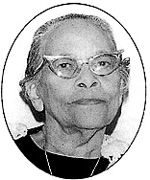Mabel Keaton Staupers facts for kids
Quick facts for kids
Mabel Keaton Staupers
|
|
|---|---|
 |
|
| Born |
Mabel Elouise Doyle
February 27, 1890 |
| Died | October 1, 1989 (aged 99) Washington, D.C.
|
| Nationality | Barbadian |
| Citizenship | Caribbean-American |
| Alma mater | Freedmen's Hospital School of Nursing |
| Known for | Nursing administration, assisting with the Booker T. Washington Sanitarium, advancing the status of African American nurses |
| Awards | Spingarn Medal 1951 American Nurses Association Hall of Fame 1996 |
| Scientific career | |
| Fields | Nursing |
Mabel Keaton Staupers (born February 27, 1890 – died October 1, 1989) was a very important nurse in America. She helped change things for the better. After she finished nursing school, she faced unfair treatment because of her race. This made her want to fight for equal rights for all nurses. She became a leader in making nursing fair for everyone.
Contents
Early Life and Education
Mabel Staupers, whose birth name was Doyle, was born in Barbados on February 27, 1890. When she was 13, in 1903, she moved to Harlem, New York, with her parents. She became an American citizen in 1917.
She studied nursing at Freedmen's Hospital School of Nursing in Washington, D.C.. She was a great student and graduated with honors in 1917. After graduating, she worked as a private nurse, helping people in their homes.
Helping Others: The Booker T. Washington Sanatorium
While working as a nurse, Mabel Staupers helped create the Booker T. Washington Sanatorium. This was a special place for African Americans who had tuberculosis. At that time, many hospitals would not let Black doctors or nurses work there. They also often refused to treat Black patients.
Mabel Staupers was the Superintendent of this sanatorium from 1920 to 1922. She used her skills to manage the center and make sure people got good care. She also worked for the Harlem Committee of the New York Tuberculosis and Health Association for 12 years.
Fighting for Equality in Nursing
Mabel Staupers was a strong activist for equal rights. She became the executive secretary of the National Association of Colored Graduate Nurses (NACGN). This group worked to improve the lives of African American nurses. Many Black nurses were not allowed into nursing schools or professional groups in some states.
Staupers, along with the NACGN president Estelle Masse Riddle, fought hard for Black nurses to be fully included in American nursing. A big part of her work was helping to end unfair rules in the military.
Desegregating the Military Nursing Corps
During World War II, the U.S. military had a strict rule. They only allowed a small number of Black nurses to join, and they kept them separate. Mabel Staupers was very upset by this. She believed that all qualified nurses should be able to serve their country, no matter their race.
She spoke out against this unfair system. She pointed out that the military wanted to draft white women as nurses, but they were not using skilled Black nurses. Because of her efforts, the U.S. Army changed its rules in January 1945. They opened the Armed Forces Nurses Corps to all applicants, regardless of race.
Later, in 1948, the American Nurses Association also allowed African American nurses to become members. After these big changes, Staupers decided to close the NACGN. She felt that the organization had finished its important mission.
Personal Life
Mabel Staupers was married twice. Her first marriage to Max Keaton ended in divorce. Her second husband was Fritz C. Staupers, who passed away in 1949. She had a son, James Latham, who died in 1967.
Mabel Staupers died on October 1, 1989, at her home in Washington, D.C. She was 99 years old.
Interesting Facts About Mabel Staupers
- In 1951, the NAACP gave Mabel Staupers the Spingarn Medal. This award recognized her amazing work for Black women workers.
- Staupers was a fantastic organizer who focused on making society fairer for everyone.
- In 1935, she attended a meeting of African American women leaders. This meeting helped create the National Council of Negro Women.
- During World War II, she worked to stop the military from using quotas. These quotas limited how many Black nurses could be hired.
- She received many honors from groups like the American Nurses Association and Howard University.
- In 1951, she wrote a book about her life called No Time for Prejudice. It tells the story of how Black nurses became integrated into nursing in the United States.

